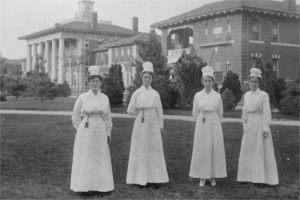
A Four-Horse Carriage Used at St. Elizabeths to Take Male Patients to Town
The Government Hospital for the Insane–better known as St. Elizabeths–accepted the insane of the District of Columbia but had a special patient population of veterans from the nation’s army and navy. Like most institutions of its kind, the asylum was beautifully landscaped and had pleasing views for the patients.
St. Elizabeths’ first superintendent, Dr. Charles Nichols, did not run to extreme treatments. If a patient were not overtly disturbed, he prescribed tonics and a nourishing diet, warm baths, and treatments for “regularity of all the alimentary functions.” Provided patients could be induced to eat (the first step on the alimentary journey), alimentary treatment consisted primarily of ensuring the bowel excreted waste properly. Physicians sometimes induced vomiting to “clean out” the system, but it was far more likely that they would administer purgatives (very strong laxatives) to make sure the bowel was completely evacuated.

Dr. Charles Nichols
As in most asylums, patients were offered work to occupy their time and distract their minds from their troubles. Patients were allowed visitors, could walk on the grounds, and enjoyed (especially early on) individual treatment plans. Theories of the time supposed that most insanity was caused by environment and habits, so every effort was made to provide “things rational, agreeable, and foreign to the subject of delusion.”

Nurses on the Lawn Across From Building E, St. Elizabeths, courtesy NARA
Whether a patient’s environment had become contaminated by overwork, marital problems, or the many pressures of life, doctors hoped that taking people away from the environment which had created their mental distress would allow them to recover. For at least the initial period of asylum growth, this belief was an overwhelmingly valid reason for insisting patients be committed to an institution rather than receive treatment at home.